Customer personas (user personas, buyer personas — whatever you call them) are more than just a marketing buzzword if you do them right.
The problem is, most of the information out there on building customer personas is incomplete at best, and misleading or incorrect at worst.
The value of buyer personas in marketing
This article assumes a rudimentary knowledge of customer personas, which Tony Zambito defined as:
Research-based archetypal (modeled) representations of who buyers are, what they are trying to accomplish, what goals drive their behavior, how they think, how they buy, and why they make buying decisions.
They’re not an exact representation of your customer, but rather an approximate model of their characteristics and attitudes to help you with marketing and product decisions.

The process of building accurate and data-driven personas is simple, but that doesn’t mean it’s easy; it takes a lot of work and rigor to construct useful personas.
Fortunately, if you put in a little effort, customer personas can bring life to your marketing across teams in your company.
Product and UX teams need personas to build product roadmaps and features, content marketers need a concrete idea of their reader, and conversion optimization specialists, well, of course we user customer personas: they help ground our conversion research in something visual and concrete.
But just because you put up a colorful poster around the office that says “Dan the Data Scientist loves the color green and is a competitive soccer player,” doesn’t mean you’ve done anything meaningful.
More often than not, I’ve seen organizations do customer personas completely wrong. Here are the four most common mistakes I’ve seen:
1. Building a persona that absolutely doesn’t exist
The story goes like this:
You read a blog post about customer personas. It’s compelling and well articulated. You realized you need to build customer personas because it will help you increase traffic, conversions, revenue, everything.
But then, for whatever reason, you decide to just make things up about some aspirational archetype that doesn’t exist in reality. Maybe it’s lack of knowledge, lack of patience, or just plain apathy, but you decide to build something that looks like this:
“Dave the Digital Marketer is a 28-year-old Digital Marketing Manager at [some tech company] that lives in a two bedroom apartment in Denver, Colorado with his dog and wine collection. His favorite color is green and he drives a Toyota Camry.”
Not only are these details incredibly irrelevant (that mistake is coming up next), but they’re (for this example) totally made up. Then you do something silly like add a cheesy stock photo to it:

You didn’t look at demographic, firmographic, behavioral, or financial data. You just assumed that because your brand should appeal to this type of person that it does.
Making up a persona from thin air serves one purpose: it gives you a concrete person to write for and to create messaging and design for. If you’re just starting out, you need this level of visualization to instill focus in your marketing (those who appeal to all people appeal to no one, after all).
But if you’re an established brand with more than 100 customers, trust the data and stick to the facts.
Even if you’re just starting out, your industry or product is rarely completely and totally new. Though it takes effort, you can gather qualitative (and quantitative) data from this target market of customers in your general industry for a more realistic picture of who is going to be buying from you.
2. Using only qualitative data
Qualitative data is easy to collect. One effective solution would be to interview your top customers (those with the highest LTV) and get some insight out of them.
Other sources of qualitative data for user personas could be session replays. Especially if you segment by those that purchased, you can find some behavioral correlations with how they viewed your website.
Finally, if you have a big enough list or database, you can send out customer surveys or put up on-site polls . Often, these will allow quantifiable insights as well (more on that in a bit).
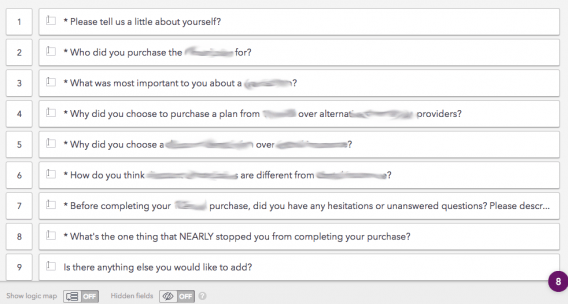
Qualitative data gives you a glimpse at your customer’s motivations, fears, beliefs, and attitudes.
There is one glaring problem with using only qualitative data, though: what people say is not always the same as what they do.
As market research expert Dr. Rob Balon put it,
While a variety of consumer research methodologies exist, and can be helpful, volition interferes with their accuracy. Unless you can measure actual buying behavior, there will always be a discrepancy between the theory and reality.
This happens in politics (polling), pricing research, and pretty much any endeavor where you ask someone what they want or what they will do. It can be enlightening, but not sufficient alone.
In building customer personas, I try to work backward: find your most valuable customer segments — behavioral, demographic, and otherwise. This is a simple matter of segmenting your customer database by LTV and analyzing behaviors and characteristics that separate them from lower value customers.
From there, you can send out an attitudinal survey with questions that tease out their buying behaviors and preferences. Stick to knowledge that will be useful for you (no “what’s your favorite TV show” type of questions probably). An example question for a digital training product could be (where the variables are rated on scales of 1-5):
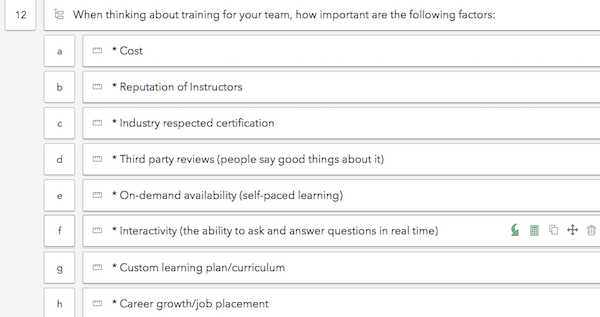
You’ll be left with quantitative data, basically rows of numbers that mean nothing until analysis, and almost nothing in aggregate.
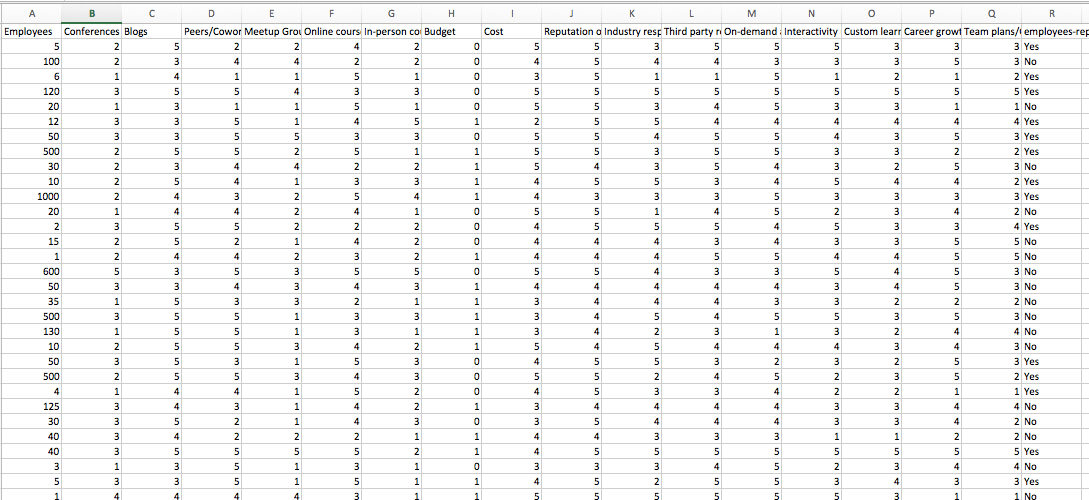
From there you can do factor analysis or principal component analysis, followed by cluster analysis, to get real data-driven personas. This requires some decently advanced analyst skills. If you lack that, you can still get perfectly actionable customer personas with digital analytics data and some basic segmenting (though you won’t get beautiful visualizations like these):
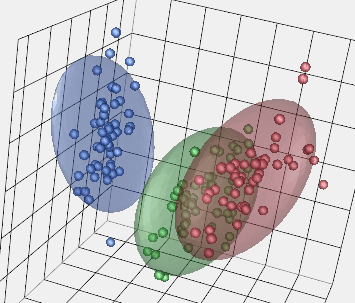
That looks pretty clean. Here’s what a k-means clustering looked like for a recent user persona project I did at CXL:
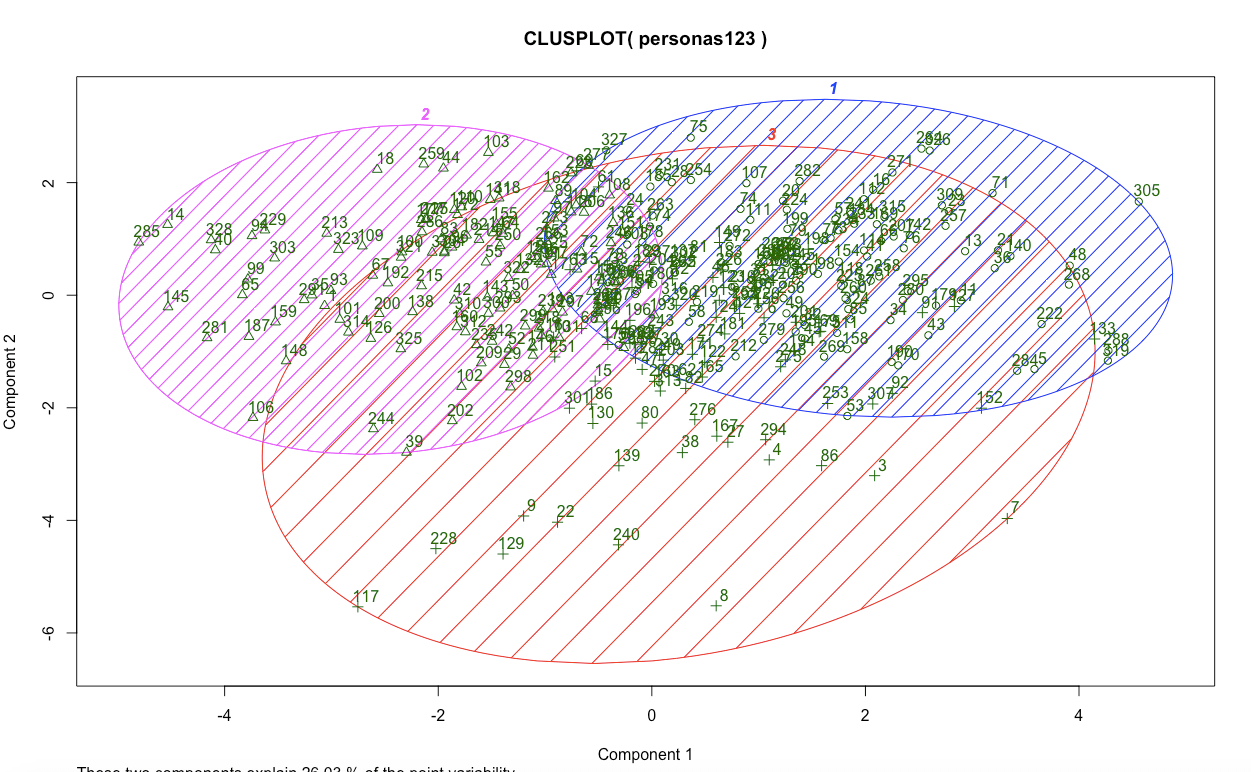
To sum up, collect and analyze on-site behavioral data, high-value customer segments, and attitudinal and preference data first. This stuff mitigates the injection of bias into your personas.
3. Using only quantitative data
The problem with quantitative insights (outside of the inherent downsides of attitudinal data), is that much of it is correlative and based on historical data, and sometimes prone to misinterpretation.
Ronny Kohavi, Distinguished Engineer at Microsoft, gave the following example:
The larger your palm, the shorter you will live, on average (with high statistical significance).
You wouldn’t believe that is causal, right? Of course not, there is a common cause: women have smaller palms and live six years longer on average.
As Kohavi put it, “obviously you wouldn’t have believed that palm size is causal, but how about observational studies about features in products reducing churn?”
So the fact that your highest value customers use site search more often and visit the FAQ page more might simply be because they’re more engaged and interested to start. Correlation doesn’t equal causation.
That’s why, in addition to honest and robust analyst work, you need to incorporate qualitative data as well. Especially in persona building, qualitative data brings a certain richness to the picture of your figurative customer. It helps you build a more complete picture of who they are and what they want.
There are two primary ways I like to collect qualitative insights for customer personas. The first is interviewing customers from key segments, one-on-one.
The way to win at customer interviews is to ask plenty of open-ended questions. Questions like the following suggested by HubSpot:
- What are the top priorities in your business at the moment?
- What are some of the best decisions you’ve made related to ____________?
- How are you feeling about your current situation related to _____________?
- If we were meeting five (10, 20) years from today, what must happen for you to feel good about your situation related to ___________?
- What opportunities do you see on your horizon?
- What challenges do you see in making this happen?
- If we were to work together on this, what are the top two or three outcomes you’d like to see?
- How will you be measuring our success related to these outcomes?
- What’s the biggest risk for you to not make progress on this situation?
Another way I like to collect this data is to survey customers. You can ask them things like:
- What matters to you most when choosing [product] online?
- What made you buy from [brand]?
- Which competitors besides [your brand] did you consider?
- What made you choose from [your brand] over other suppliers?
- Which doubts or hesitations did you have before buying from [your brand]?
And on and on. There’s a whole art and science to this stuff, and I won’t dive too deep in. The point is, color your customer personas with some why (qualitative) behind the what (quantitative).
4. Using irrelevant data to build your personas
This mistake is almost a continuation of the first one (making up data), but it involves adding in data that is purely irrelevant.
You can make it up out of nowhere (“Mike likes tangerines more than apples”), or you can derive it from your qualitative research honestly, but the point is the same: irrelevant data just makes the messaging cloudier.
A good rule of thumb is if you’re spending too much time debating which stock photo to use for your persona, you’re missing the forest for the trees.
Adele Revella gave a wonderful list of relevant insights you need (specifically for content marketing, but can be extrapolated to other purposes):
- Priority initiatives: 3-5 problems or objects that your buyer persona dedicates time, budget, and political/social capital to
- Success factors: Tangible or intangible metrics or rewards that the buyer associates with success
- Perceived barriers: What factors could prompt the buyer to question whether your company and its solution can help with achieving his or her success factors?
- Buying process: The process your customer follows in exploring and selecting a solution that can overcome the perceived barriers and achieve their success factors
- Decision criteria: The aspects of each product the buyer will assess when making a decision. As Revella advises, “the decision criteria should include insights both from buyers who chose a competitor and those who decide not to buy a solution at all.”
This advice isn’t new: analysis paralysis is bad. Stick to the data and insights that you can use to make decisions.
Be careful creating buyer personas
While there are frameworks based on personality types for building customer personas, I prefer to use my own data. This doesn’t mean that frameworks and heuristics can’t help you. In the absence of data, they can provide a mental model by which to operate.
Always connect all your ads to personalized post-click landing pages to lower your cost per customer acquisition. Start creating your dedicated post-click pages by signing up for an Instapage Enterprise demo today.

See the Instapage Enterprise Plan in Action.
Demo includes AdMap™, Personalization, AMP,
Global Blocks, heatmaps & more.
